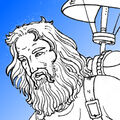Template:Selected anniversaries/April 15: Difference between revisions
No edit summary |
No edit summary |
||
| (67 intermediate revisions by the same user not shown) | |||
| Line 1: | Line 1: | ||
<gallery> | <gallery> | ||
File:Leonardo by Meizi.jpg|link=Leonardo da Vinci (nonfiction)|1452: Polymath [[Leonardo da Vinci (nonfiction)|Leonardo da Vinci]] born. His areas of interest will | File:Leonardo by Meizi.jpg|link=Leonardo da Vinci (nonfiction)|1452: Polymath [[Leonardo da Vinci (nonfiction)|Leonardo da Vinci]] born. His areas of interest will include painting, sculpting, architecture, invention, science, music, mathematics, engineering, literature, anatomy, geology, astronomy, botany, writing, history, and cartography. | ||
File: | |||
File:Leonardo_da_Vinci_in_flight.jpg|link=Leonardo da Vinci|1488: Polymath [[Leonardo da Vinci]] publishes groundbreaking treatise on applications of the [[Gnomon algorithm]] principle to powered flight. | |||
File:Due_lettioni_date_nella_academia_erigenda_dove_si_mostra_come_si_trovi_la_grandezza_delle_superficie_rettilinee.jpg|link=Pietro Cataldi (nonfiction)|1552: Mathematician and astronomer [[Pietro Cataldi (nonfiction)|Pietro Cataldi]] born. Cataldi will contribute to the development of continued fractions and a method for their representation; he will also discover the sixth and seventh perfect numbers by 1588. | |||
File:Leonhard Euler.jpg|link=Leonhard Euler (nonfiction)|1707: Mathematician and physicist [[Leonhard Euler (nonfiction)|Leonhard Euler]] born. He will make important and influential discoveries in many branches of mathematics, and will introduce much of the modern mathematical terminology and notation, such as the notion of a mathematical function. | File:Leonhard Euler.jpg|link=Leonhard Euler (nonfiction)|1707: Mathematician and physicist [[Leonhard Euler (nonfiction)|Leonhard Euler]] born. He will make important and influential discoveries in many branches of mathematics, and will introduce much of the modern mathematical terminology and notation, such as the notion of a mathematical function. | ||
File: | |||
File: | File:Peder Horrebow.jpg|link=Peder Horrebow (nonfiction)|1764: Astronomer and mathematician [[Peder Horrebow (nonfiction)|Peder Horrebow]] dies. he invent a way to determine a place's latitude from the stars. | ||
File:Ernst_Ruhmer,_Technical_World_cover_(1905).jpg|link=Ernst Ruhmer (nonfiction)|1878: Physicist [[Ernst Ruhmer (nonfiction)|Ernst Ruhmer]] born. Ruhmer will invent applications for the light-sensitivity properties of selenium, including wireless telephony using line-of-sight optical transmissions, sound-on-film audio recording, and television transmissions over wires. | |||
File:Johannes Bosscha.jpg|link=Johannes Bosscha (nonfiction)|1911: Physicist [[Johannes Bosscha (nonfiction)|Johannes Bosscha Jr.]] dies. Bosscha made important investigations on galvanic polarization and the rapidity of sound waves; he was one of the first (1855) to suggest the possibility of sending two messages simultaneously over the same wire. | |||
</gallery> | </gallery> | ||
Latest revision as of 03:11, 15 April 2022
1452: Polymath Leonardo da Vinci born. His areas of interest will include painting, sculpting, architecture, invention, science, music, mathematics, engineering, literature, anatomy, geology, astronomy, botany, writing, history, and cartography.
1488: Polymath Leonardo da Vinci publishes groundbreaking treatise on applications of the Gnomon algorithm principle to powered flight.
1552: Mathematician and astronomer Pietro Cataldi born. Cataldi will contribute to the development of continued fractions and a method for their representation; he will also discover the sixth and seventh perfect numbers by 1588.
1707: Mathematician and physicist Leonhard Euler born. He will make important and influential discoveries in many branches of mathematics, and will introduce much of the modern mathematical terminology and notation, such as the notion of a mathematical function.
1764: Astronomer and mathematician Peder Horrebow dies. he invent a way to determine a place's latitude from the stars.
1878: Physicist Ernst Ruhmer born. Ruhmer will invent applications for the light-sensitivity properties of selenium, including wireless telephony using line-of-sight optical transmissions, sound-on-film audio recording, and television transmissions over wires.
1911: Physicist Johannes Bosscha Jr. dies. Bosscha made important investigations on galvanic polarization and the rapidity of sound waves; he was one of the first (1855) to suggest the possibility of sending two messages simultaneously over the same wire.






